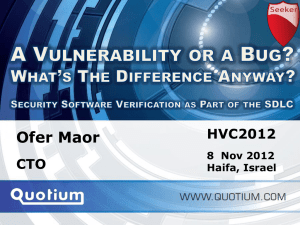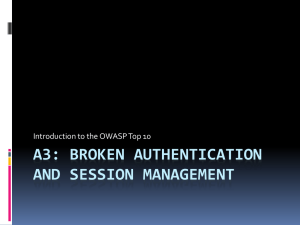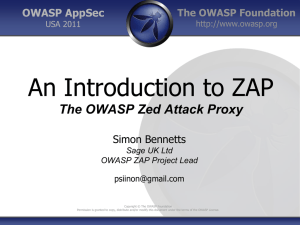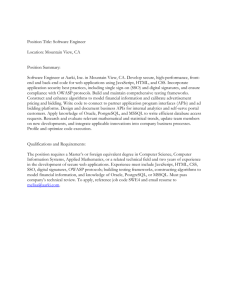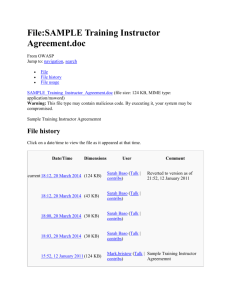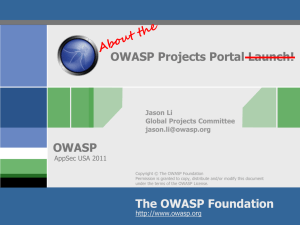"The Core Rule Set": Generic detection of application layer
advertisement
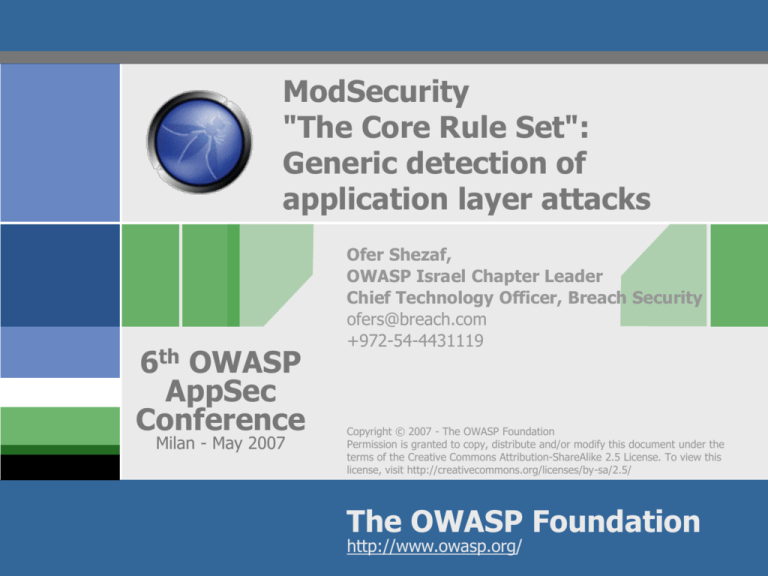
ModSecurity
"The Core Rule Set":
Generic detection of
application layer attacks
6th OWASP
AppSec
Conference
Milan - May 2007
Ofer Shezaf,
OWASP Israel Chapter Leader
Chief Technology Officer, Breach Security
ofers@breach.com
+972-54-4431119
Copyright © 2007 - The OWASP Foundation
Permission is granted to copy, distribute and/or modify this document under the
terms of the Creative Commons Attribution-ShareAlike 2.5 License. To view this
license, visit http://creativecommons.org/licenses/by-sa/2.5/
The OWASP Foundation
http://www.owasp.org/
About The Speaker
Community Participation:
ModSecurity Core Rule Set Project Leader
OWASP Israeli chapter leader
Web Application Security Consortium (WASC) Board
Member
WASC Web Hacking
Incidents Database
Project Leader
Day Job:
CTO, Breach Security
In charge of security
research, rules and
signatures.
6th OWASP AppSec Conference – Milan – May 2007
What are we going to talk about
What are Application Firewalls
Application Firewalls vs. IDPS
The Core Rule Set:
Protocol Compliance and Policy
App Layer Signatures detection
Odds and Ends
6th OWASP AppSec Conference – Milan – May 2007
3
"The Core Rule Set":
Generic detection of application layer attacks
Ofer Shezaf
ofers@breach.com
About Application Firewalls
The OWASP Foundation, http://www.owasp.org/
6th OWASP AppSec Conference, Milan - May 2007
Multiple Deployment Modes
Web
Server
In-Line mode
`
Firewall
Web
Server
Embedded mode
`
Firewall
Web
Server
Out of line mode
`
Firewall
6th OWASP AppSec Conference – Milan – May 2007
2 ½ Protection Strategies
External patching
Also known as "just-in-time patching" or "virtual patching"
Positive security model
An independent input validation envelope
Rules must be adjusted to the application
Automated and continuous learning (to adjust for
changes) is the key
Negative security model
IPS?
Looking for bad stuff
Mostly signatures based
Generic but requires some tweaking for each application
6th OWASP AppSec Conference – Milan – May 2007
6
Virtual Patching
Testing reveals that the login field is vulnerable
to SQL injection.
Login names cannot include characters beside
alphanumerical characters.
The following rule will help:
<LocationMatch "^/app/login.asp$">
SecRule ARGS:username "!^\w+$" "deny,log"
>/LocationMatch>
6th OWASP AppSec Conference – Milan – May 2007
Positive Security
<LocationMatch "^/exchweb/bin/auth/owaauth.dll$">
SecDefaultAction "log,deny,t:lowercase"
SecRule REQUEST_METHOD !POST
SecRule ARGS:destination " URL" "t:urlDecode"
SecRule ARGS:flags “![0-9]{1,2}"
SecRule ARGS:username "[0-9a-zA-Z].{256,}"
SecRule ARGS:password ".{256,}"
SecRule ARGS:SubmitCreds "!Log.On"
SecRule ARGS:trusted "!(0|4)"
</LocationMatch>
The same, but for every field in every application
Very hard to create, requires learning by:
Monitoring outbound traffic (match input to web server
request). Caveats: JavaScript, Web Services
Monitoring inbound traffic (normal behavior). Caveats:
Statistics, attacks in learning period
6th OWASP AppSec Conference – Milan – May 2007
8
Positive Security
Site
Site Status
Site Map
URLs
Parameter
Types
Parameters
6th OWASP AppSec Conference – Milan – May 2007
9
"The Core Rule Set":
Generic detection of application layer attacks
Ofer Shezaf
ofers@breach.com
Web Application Firewalls vs.
Intrusion Prevention Systems
The OWASP Foundation, http://www.owasp.org/
6th OWASP AppSec Conference, Milan - May 2007
Negative Security: An IPS, but
Deep understanding of HTTP and HTML
Breaking up to individual fields: headers, parameters, uploaded files.
Validation of field attributes such as content, length or count
Correct breakup and matching of transactions and sessions.
Compensation for protocol caveats and anomalies, for example cookies.
Robust parsing:
Unique parameters syntax
XML requests (SOAP, Web Services)
Anti Evasion features:
Decoding
Path canonizations
Thorough understanding of application layer issues: Apache request line
delimiters, PHP parameter names anomalies.
Rules instead of signatures:
Sessions & state management, Logical operators, Control structures.
6th OWASP AppSec Conference – Milan – May 2007
11
IDPS signatures vs. WAF Rules
Signatures:
Simple text strings or regular
expression patterns matched
against input data.
Usually detect attack vectors for
known vulnerabilities, while web
applications are usually custom
made.
Variations on attack vectors are
very easy to create
Rules:
Multiple operators and logical
expressions: Is password field
length > 8?
Selectable anti-evasion
transformation functions.
Control structures such as IF:
Apply different rules based on
transactions.
Variables, Session & state
management:
Aggregate events over a sessions.
Detect brute force & denial of
service.
Audit user name for each
transaction
6th OWASP AppSec Conference – Milan – May 2007
Some Complex Rules:
Monitoring:
Protection
Capturing the user name
Login failures
Brute force detection
Scanners and automation
detection
Misdemeanor scoring
State
Collection
Comparison
Operator
Anti
Evasion??
SecAction phase:1,nolog,pass,initcol:ip=%{REMOTE_ADDR}_%{HTTP_USER-AGENT}
SecRule IP:SCORE "@ge 20" "phase:1,pass,log,setvar:ip.blocked=1,expirevar:ip.blocked=600"
SecRule IP:BLOCKED "@eq 1" "phase:1,deny,log,status:302,redirect:http://www.site.com/"
SecRule REQUEST_FILENAME "login\.jsp$"
"phase:1,pass,nolog,setvar:ip.score=+1,expirevar:ip.score=600"
Rate
control
6th OWASP AppSec Conference – Milan – May 2007
13
"The Core Rule Set":
Generic detection of application layer attacks
Ofer Shezaf
ofers@breach.com
The Core Rule Set
The OWASP Foundation, http://www.owasp.org/
6th OWASP AppSec Conference, Milan - May 2007
Generic detection of app layer attacks
Core Rule Set available for ModSecurity at:
http://www.modsecurity.org/projects/rules/index.html
Probably translatable to any App Firewall
Benefits from ModSecurity features:
Anti Evasion
Granular Parsing
Detection Mechanisms:
Protocol Validation
Generic Attack Signatures
Known Vulnerabilities Signatures
More…
6th OWASP AppSec Conference – Milan – May 2007
"The Core Rule Set":
Generic detection of application layer attacks
Ofer Shezaf
ofers@breach.com
Protocol Validation
The OWASP Foundation, http://www.owasp.org/
6th OWASP AppSec Conference, Milan - May 2007
Protocol Violations
Protocol vulnerabilities such as Response
Splitting, Request Smuggling, Premature URL
ending:
Content length only for none GET/HEAD methods
Non ASCII characters or encoding in headers.
Valid use of headers (for example, content length is
numerical)
Proxy Access
Attack requests are different due to automation:
Missing headers such as Host, Accept, User-Agent.
Host is an IP address.
6th OWASP AppSec Conference – Milan – May 2007
Case study: Full Width Unicode Evasion
CERT VU#739224, May 14th 2007
http://www.kb.cert.org/vuls/id/739224
Two levels of a solution:
ModSecurity: decode right
Expected shortly
Core Rule Set: block full/half width Unicode
ready, available online tomorrow
SecRule
REQUEST_FILENAME|ARGS|ARGS_NAMES|REQUEST_HEADERS|XML:/*|!RE
QUEST_HEADERS:Referer "\%u[fF]{2}[0-9a-fA-F]{2}" \
"t:none,deny,log,auditlog,status:400,msg:'Unicode Full/Half Width Abuse Attack
Attempt',,id:'950116',severity:'4'"
6th OWASP AppSec Conference – Milan – May 2007
18
Protocol Policy
Policy is usually application specific:
Some restrictions can usually be applied generically.
White lists can be build for specific environments.
Items that can be allowed or restricted:
Methods - Allow or restrict WebDAV, block abused
methods such as CONNECT, TRACE or DEBUG.
File extensions – backup files, database files, ini files.
Content-Types (and to some extent other headers)
Limitations on sizes:
Request size, Upload size,
# of parameters, length of parameter.
6th OWASP AppSec Conference – Milan – May 2007
19
"The Core Rule Set":
Generic detection of application layer attacks
Ofer Shezaf
ofers@breach.com
Application Layer Signatures
The OWASP Foundation, http://www.owasp.org/
6th OWASP AppSec Conference, Milan - May 2007
Case study: 1=1
Classic example of an SQL injection attack.
Often used as a signature.
But, can be avoided easily using:
Encoding: 1%3D1
White Space: 1
=%091
Comments 1 /* This is a comment */ = 1
Actually not required at all by attacker.
Any true expression would work: 2 > 1
In some cases, a constant would also work. In MSAccess all the following are true: 1, “1”, “a89”, 4-4.
No simple generic detection
6th OWASP AppSec Conference – Milan – May 2007
Generic application layer signatures
Detect attack indicators and not attack vectors:
xp_cmdshell,
“<“, single quote - Single quote is very much needed
to type O'Brien
select, union – which are English words
Aggregate indicators to determine an attack:
Very strong indicators: xp_cmdshell, varchar,
Sequence: union …. select, select … top … 1
Amount: script, cookie and document appear in the
same input field.
Sequence over multiple requests from the same
source.
6th OWASP AppSec Conference – Milan – May 2007
Snort signature
for Bugtraq vulnerability #21799
Exploit:
/cacti/cmd.php?1+1111)/**/UNION/**/SELECT/**/2,0,1,1,127
.0.0.1,null,1,null,null,161,500, proc,null,1,300,0, ls la > ./rra/suntzu.log,null,null/**/FROM/**/host/*+11111
Snort Signature:
alert tcp $EXTERNAL_NET
any -> $HTTP_SERVERS
$HTTP_PORTS
Does the
Signature built for
application
(
specific exploit
accepts POST
msg:"BLEEDING-EDGE WEB Cacti cmd.php Remote Arbitrary
requests?
SQL Command Execution Attempt";
flow:to_server,established;
uricontent:"/cmd.php?"; nocase;
uricontent:"UNION"; nocase;
uricontent:"SELECT"; nocase;
An SQL injection
reference:cve,CVE-2006-6799; reference:bugtraq,21799;
does not have to use
UNION and classtype: web-application-attack;
sid:2003334; rev:1;
SELECT or UNION
SELECT are
common )
English
words. So is
SELECTION
6th OWASP AppSec Conference – Milan – May 2007
Back to Bugtraq vulnerability #21799
The Core Rule Set Generic Detection
Supports any type
of parameters,
POST , GET
or any
SecRule
REQUEST_FILENAME|ARGS|ARGS_NAMES|
other
REQUEST_HEADERS|!REQUEST_HEADERS:Referer \
"(?:\b(?:(?:s(?:elect\b(?:.{1,100}?\b(?:(?:length|count|top)\b.{1,100
}?\bfrom|from\b.{1,100}?\bwhere)|.*?\b(?:d(?:ump\b.*\bfrom|ata_type)|(?:
to_(?:numbe|cha)|inst)r))|p_(?:(?:addextendedpro|sqlexe)c|(?:oacreat|prep
Every SQL injection
ar)e|execute(?:sql)?|makewebtask)|ql_(?:… … … \
related keyword is
checked
“capture,log,deny,t:replaceComments, t:urlDecodeUni,
t:htmlEntityDecode, t:lowercase,msg:'SQL Injection Attack. Matched
signature <%{TX.0}>',id:'950001',severity:'2'“
Common evasion
techniques are
mitigated
SQL comments are
compensated for
6th OWASP AppSec Conference – Milan – May 2007
Back to Bugtraq vulnerability #21799
Virtual Patching
<LocationMatch :"/cmd.php$">
SecRule QUERY_STRING "^[\d\s]*$” “deny,log"
>/LocationMatch>
Parameters Must
Be Numeric
Or
SecRule REQUEST_FILENAME :"/cmd.php$" “deny,log"
Actually script
should not be run
remotely
Simpler, isn’t it?
6th OWASP AppSec Conference – Milan – May 2007
Odds and Ends
6th OWASP
AppSec
Conference
Milan - May 2007
Copyright © 2007 - The OWASP Foundation
Permission is granted to copy, distribute and/or modify this document under the
terms of the Creative Commons Attribution-ShareAlike 2.5 License. To view this
license, visit http://creativecommons.org/licenses/by-sa/2.5/
The OWASP Foundation
http://www.owasp.org/
Malicious Robots
Detection of malicious robots:
Unique request attributes: User-Agent header, URL, Headers
Black list of IP addresses
Rate based detection
Not aimed against targeted attacks, but against general
malicious internet activity:
Offloads a lot of cyberspace junk & noise
Effective against comment spam.
Reduce event count.
In addition:
Detection of security scanners
Detection of non malicious robots (such as search engines).
Confusing security testing software (HTTPrint)
6th OWASP AppSec Conference – Milan – May 2007
27
Trojans and Viruses
Major problem at hosting environments
Uploading is allowed.
Some sites may be secure while others not.
Generic detection:
Check upload of Viruses.
Check upload of Trojans:
AV software is not very good at that.
Check for access to Trojans:
Known signatures (x_key header)
Generic file management output (gid, uid, drwx, c:\)
6th OWASP AppSec Conference – Milan – May 2007
Error conditions
Last line of defense if all else fails
Provide feedback to application developers
Important for customer experience
Makes life for the hacker harder
6th OWASP AppSec Conference – Milan – May 2007
Thank You!
Ofer Shezaf
ofers@breach.com
6th OWASP
AppSec
Conference
Milan - May 2007
Copyright © 2007 - The OWASP Foundation
Permission is granted to copy, distribute and/or modify this document under the
terms of the Creative Commons Attribution-ShareAlike 2.5 License. To view this
license, visit http://creativecommons.org/licenses/by-sa/2.5/
The OWASP Foundation
http://www.owasp.org/

